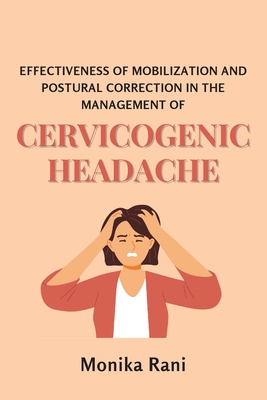You are here
Back to topEffectiveness of Mobilization and Postural Correction in the Management of Cervicogenic Headache (Paperback)
$32.99
Email or call for price
Email or call for price
Description
Cervicogenic headache is the secondary headache which occurs mainly due to imbalances in articular, muscular and neural impairment which leads to pain, functional disability and impaired quality of life. Purpose: To evaluate the effectiveness of spinal mobilization, neural mobilization and postural correction exercises in participants suffering from cervicogenic headache. Methodology: A parallel-group, participant-blinded, randomized controlled trial with concealed allocation was conducted. A total of 140 participants with cervicogenic headache (diagnosed based on Sjaastad criteria) were included according to sample size calculation. Written informed consent was obtained from them based on declaration of Helsinki. Then participants were randomly allocated into four groups by computer random tables: spinal mobilization group, neural mobilization group, postural correction exercises group and control group. Before starting the intervention participants were physically examined and treatment was given accordingly. Spinal mobilization group received translatoric glide for C1 vertebra, postero-anterior and lateral glide for C2, C3 vertebrae, and headache sustained natural apophyseal glide. Neural mobilization group received Shacklock neural mobilization for headache, and neural mobilization of meninges, brachial plexus and trigeminal nerve. Postural correction exercises group received cervical muscle stretching exercises for tight muscles, strengthening exercises and endurance exercise for weaker muscle group. General range of motion exercises were given in control group. The treatment was provided over 4 week for 4 times a week (16 sessions). The primary outcome measure was headache impact test-6 for headache-related disability. The secondary outcome included headache diary for headache intensity, headache frequency, and headache duration, neck disability index for neck pain-related disability. All outcome measures were assessed at baseline (preintervention at 0 week), immediately after intervention (post-intervention at 4thweek) and follow-up (after 1 month). The statistical method used for data analysis was one-way ANOVA test for baseline comparison of data. Shapiro-Wilk test was used for analyzing the normality of the data. As the data were not normally distributed, therefore, Freidman test was used to analyze the with-in group effect with its post hoc test i.e. Wilcoxon-Sign Rank test and the Kruskal-Wallis test was used to analyze between-groups effects with its post-hoc test i.e. Mann Whitney U test. The post-hoc test was applied with Bonferroni correction. There v may be possibilities that the baseline values of the outcome act as a covariate. Therefore, bootstrap regression analysis was conducted at the post-intervention and follow-up time points for each outcome with the group as an independent variable and baseline value of the outcome as a covariate.

